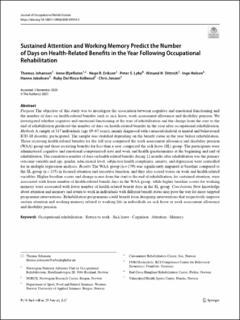| dc.contributor.author | Johansen, Thomas | |
| dc.contributor.author | Øyeflaten, Irene Larsen | |
| dc.contributor.author | Eriksen, Hege Randi | |
| dc.contributor.author | Lyby, Peter Solvoll | |
| dc.contributor.author | Dittrich, Winand H. | |
| dc.contributor.author | Holsen, Inge N. | |
| dc.contributor.author | Jakobsen, Hanne | |
| dc.contributor.author | Kollerud, Ruby Del Risco | |
| dc.contributor.author | Jensen, Chris | |
| dc.date.accessioned | 2021-07-12T07:40:17Z | |
| dc.date.available | 2021-07-12T07:40:17Z | |
| dc.date.created | 2021-05-05T14:33:30Z | |
| dc.date.issued | 2021 | |
| dc.identifier.citation | Journal of occupational rehabilitation. 2021, 1-12. | en_US |
| dc.identifier.issn | 1053-0487 | |
| dc.identifier.uri | https://hdl.handle.net/11250/2764111 | |
| dc.description.abstract | Purpose The objective of this study was to investigate the association between cognitive and emotional functioning and the number of days on health-related benefits such as sick leave, work assessment allowance and disability pension. We investigated whether cognitive and emotional functioning at the start of rehabilitation and the change from the start to the end of rehabilitation predicted the number of days on health-related benefits in the year after occupational rehabilitation. Methods A sample of 317 individuals (age 19–67 years), mainly diagnosed with a musculoskeletal or mental and behavioural ICD-10 disorder, participated. The sample was stratified depending on the benefit status in the year before rehabilitation. Those receiving health-related benefits for the full year comprised the work assessment allowance and disability pension (WAA) group and those receiving benefits for less than a year comprised the sick leave (SL) group. The participants were administered cognitive and emotional computerised tests and work and health questionnaires at the beginning and end of rehabilitation. The cumulative number of days on health-related benefits during 12 months after rehabilitation was the primary outcome variable and age, gender, educational level, subjective health complaints, anxiety, and depression were controlled for in multiple regression analyses. Results The WAA group (n = 179) was significantly impaired at baseline compared to the SL group (n = 135) in focused attention and executive function, and they also scored worse on work and health related variables. Higher baseline scores and change scores from the start to the end of rehabilitation, for sustained attention, were associated with fewer number of health-related benefit days in the WAA group, while higher baseline scores for working memory were associated with fewer number of health-related benefit days in the SL group. Conclusions New knowledge about attention and memory and return to work in individuals with different benefit status may pave the way for more targeted programme interventions. Rehabilitation programmes could benefit from designing interventions that respectively improve sustain attention and working memory related to working life in individuals on sick leave or work assessment allowance and disability pension. | en_US |
| dc.language.iso | eng | en_US |
| dc.rights | Navngivelse 4.0 Internasjonal | * |
| dc.rights.uri | http://creativecommons.org/licenses/by/4.0/deed.no | * |
| dc.title | Sustained attention and working memory predict the number of days on health-related benefits in the year following occupational rehabilitation | en_US |
| dc.type | Peer reviewed | en_US |
| dc.type | Journal article | en_US |
| dc.rights.holder | © 2021, Author(s) | |
| dc.description.version | publishedVersion | en_US |
| cristin.ispublished | true | |
| cristin.fulltext | original | |
| cristin.qualitycode | 1 | |
| dc.identifier.doi | 10.1007/s10926-020-09944-5 | |
| dc.identifier.cristin | 1908242 | |
| dc.source.journal | Journal of occupational rehabilitation | en_US |
| dc.source.pagenumber | 1-12 | en_US |
| dc.relation.project | Helse Nord RHF: SFP1173-14 | en_US |

